Genet (animal) facts for kids
Quick facts for kids Genet |
|
|---|---|
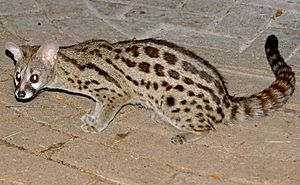 |
|
| Scientific classification |
|
| Kingdom: | Animalia |
| Phylum: | Chordata |
| Class: | Mammalia |
| Order: | Carnivora |
| Suborder: | Feliformia |
| Family: | Viverridae |
| Subfamily: | Viverrinae |
| Genus: | Genetta Cuvier, 1816 |
| Type species | |
| Viverra genetta Linnaeus, 1758
|
|
| Species | |
|
See text |
|
A genet is a small, cat-like animal that lives in Africa. There are about 14 to 17 different kinds, or species, of genets. They are part of a group of animals called carnivores, which means they mostly eat meat. The common genet is the only type of genet found in Europe, living in places like Spain, Portugal, and France.
Scientists have found old genet fossils in Africa, showing these animals have been around for millions of years.
Contents
Types of Genets
The group of animals called Genetta was first described by Frédéric Cuvier in 1816. Scientists are still figuring out the exact number of genet species. Here are some of the known types:
| Image | Name | Where they live |
|---|---|---|
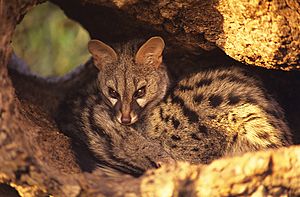 |
Common genet (G. genetta) |  |
 |
Cape genet (G. tigrina) | 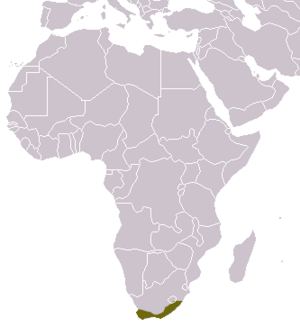 |
| South African small-spotted genet (G. felina) | ||
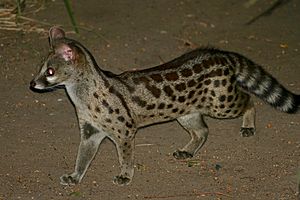 |
Rusty-spotted genet (G. maculata) |  |
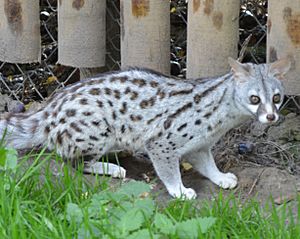 |
Pardine genet (G. pardina) | 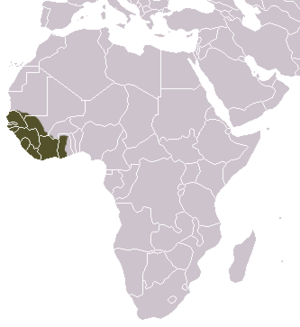 |
| Abyssinian genet (G. abyssinica) | 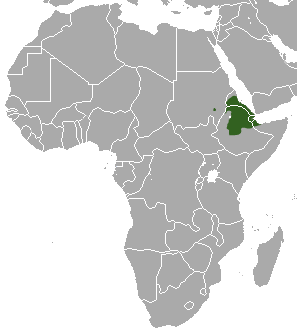 |
|
| King genet (G. poensis) | 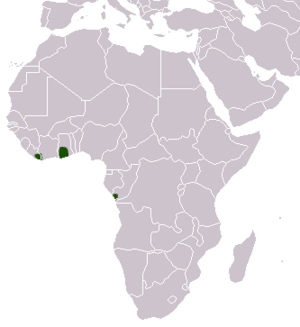 |
|
 |
Servaline genet (G. servalina) |  |
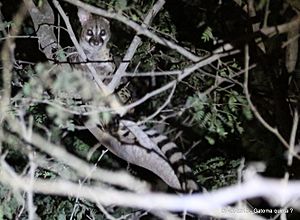 |
Angolan genet (G. angolensis) | 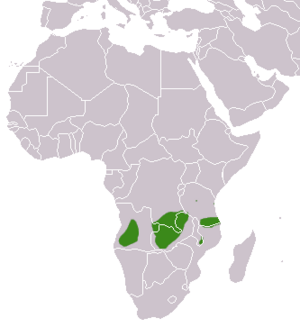 |
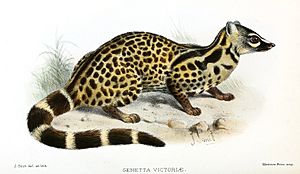 |
Giant forest genet (G. victoriae) |  |
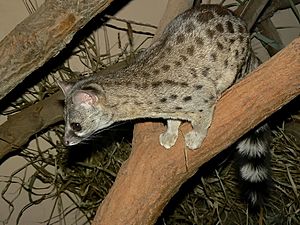 |
Hausa genet (G. thierryi) | 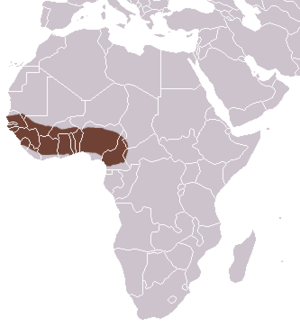 |
| Letaba genet (G. letabae) | ||
| Johnston's genet (G. johnstoni) | 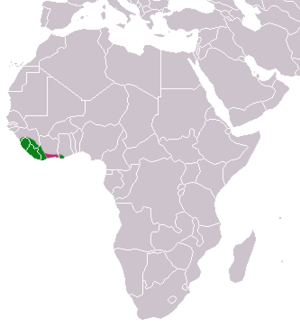 |
|
| Aquatic genet (G. piscivora) |  |
|
 |
Crested servaline genet (G. cristata) | 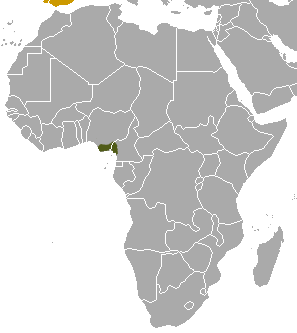 |
| Schouteden’s genet (G. schoutedeni) | ||
| Bourlon's genet (G. bourloni) |
What Genets Look Like
Genets are thin and look a lot like cats. They have long bodies and long, ringed tails. Their ears are large, and their noses are pointed. They have claws that can partly pull back, just like a cat's.
Their fur usually has spots, but some genets are completely black. Genets also have special glands that produce a strong smell, which they use to communicate.
Different Genet Features
All genet species have a dark stripe running down their back. Their fur color and spot patterns can be different. Genets are usually between 40.9 and 60 centimeters (about 16 to 24 inches) long, not including their tails. Their tails are almost as long as their bodies, measuring 40 to 47 centimeters (about 16 to 18.5 inches).
They have big eyes with pupils that are shaped like ovals. Their eyes are usually the same color as their fur. Genets can move their eyes a little bit, but they mostly move their heads to follow things that are moving. Their ears can move in many directions, helping them hear very well. Their wet noses are important for both smelling and touching.
Where Genets Live
All types of genets originally come from Africa. The common genet was brought to southwestern Europe a long time ago. People likely brought them from North Africa to the Mediterranean Sea region about 1,000 to 1,500 years ago. From there, they spread into southern France and Italy.
In Africa, common genets live in wooded areas north of the Sahara Desert. They also live in savannas south of the Sahara, all the way down to South Africa, and along the coasts of Arabia, Yemen, and Oman.
Other genet species live in specific parts of Africa:
- The Cape genet lives only in South Africa in areas with shrubs, grasslands, and coastal forests.
- The South African small-spotted genet lives in woodlands, grasslands, and thickets in countries like Angola and Namibia.
- The rusty-spotted genet is found across many parts of sub-Saharan Africa, in woodlands, rainforests, and mountains.
- The pardine genet lives in rainforests and woodlands from Senegal to Ghana.
- The Abyssinian genet lives in dry mountain forests in Ethiopia.
- The King genet is found only in the rainforests of the Congo Basin and on Bioko Island.
- The servaline genet lives in forests across Central Africa, even in high-altitude bamboo forests.
- The Angolan genet lives in open woodlands from Angola to central Tanzania.
- The giant forest genet lives in the rainforests of the Democratic Republic of the Congo and western Uganda.
- The Hausa genet lives in savannas and moist woodlands in West Africa.
- Johnston's genet lives in dense rainforests in Upper Guinea.
- The aquatic genet lives in rainforests between the Congo River and the Rift Valley.
- The crested servaline genet is found only in Nigeria and Cameroon, living in scrub and forests.
- Schouteden’s genet lives in rainforests and savannas across tropical Africa.
- Bourlon's genet lives only in the Upper Guinean rainforests in West Africa.
Genet Behavior and Diet
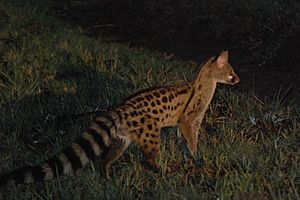
Genets are very quick and good at climbing. They are the only animals in their family (viverrids) that can stand on their back legs. They can walk, trot, run, climb up and down trees, and jump. They spend time both on the ground and in trees. Genets usually live alone, except when they are mating or when a mother is raising her young.
Genets are omnivores, meaning they eat both plants and animals. They are also opportunistic feeders, which means they will eat whatever food they can find. They catch insects and small animals, but they also eat plants and fruit. The aquatic genet mainly eats fish. Some genets, like the Angolan genet, are thought to eat mostly grasshoppers and other insects.
In 2014, a camera caught a large spotted genet riding on the backs of a buffalo and a rhinoceros! This was the first time anyone had seen a genet "hitch-hiking" like that.
Genet Reproduction and Life Cycle
Female genets can have up to five babies at a time. They raise their young by themselves.
Common genet females are ready to have babies when they are about two years old. They are pregnant for about 10 to 11 weeks. They can have babies twice a year, once in the spring and again in late summer or autumn. Genets in zoos have been known to live for up to 13 years, and one male genet lived for almost 23 years!
Threats to Genets
Some genet species are in danger because their homes are being destroyed. Forests are cut down, and land is turned into farms. This is a big problem for the crested servaline genet and Johnston's genet. People also hunt these genets for their meat and skins. Because of these threats, they are listed as Vulnerable on the IUCN Red List, which tracks endangered animals. Bourlon's genet is also facing similar threats and is listed as Near Threatened.
The aquatic genet might be affected by hunting, but scientists don't know enough about the main threats to it yet. It is also listed as Near Threatened.
We don't know much about the King genet and the Abyssinian genet, so it's hard to say what threatens them. They are listed as Data Deficient.
Most other genet species are not considered to be in danger right now and are listed as Least Concern.
Etymology
The word 'genet' has an interesting history. It might come from an old Greek word meaning "bear" combined with a Latin word meaning "small." Or it could come from the Arabic word djarnet, or from old French or Spanish words for the animal.
Genets as Pets
Some people keep genets as pets. The most common types of genets kept as pets are the common genet, rusty-spotted genet, or Cape genet.
See also
 In Spanish: Jineta para niños
In Spanish: Jineta para niños



